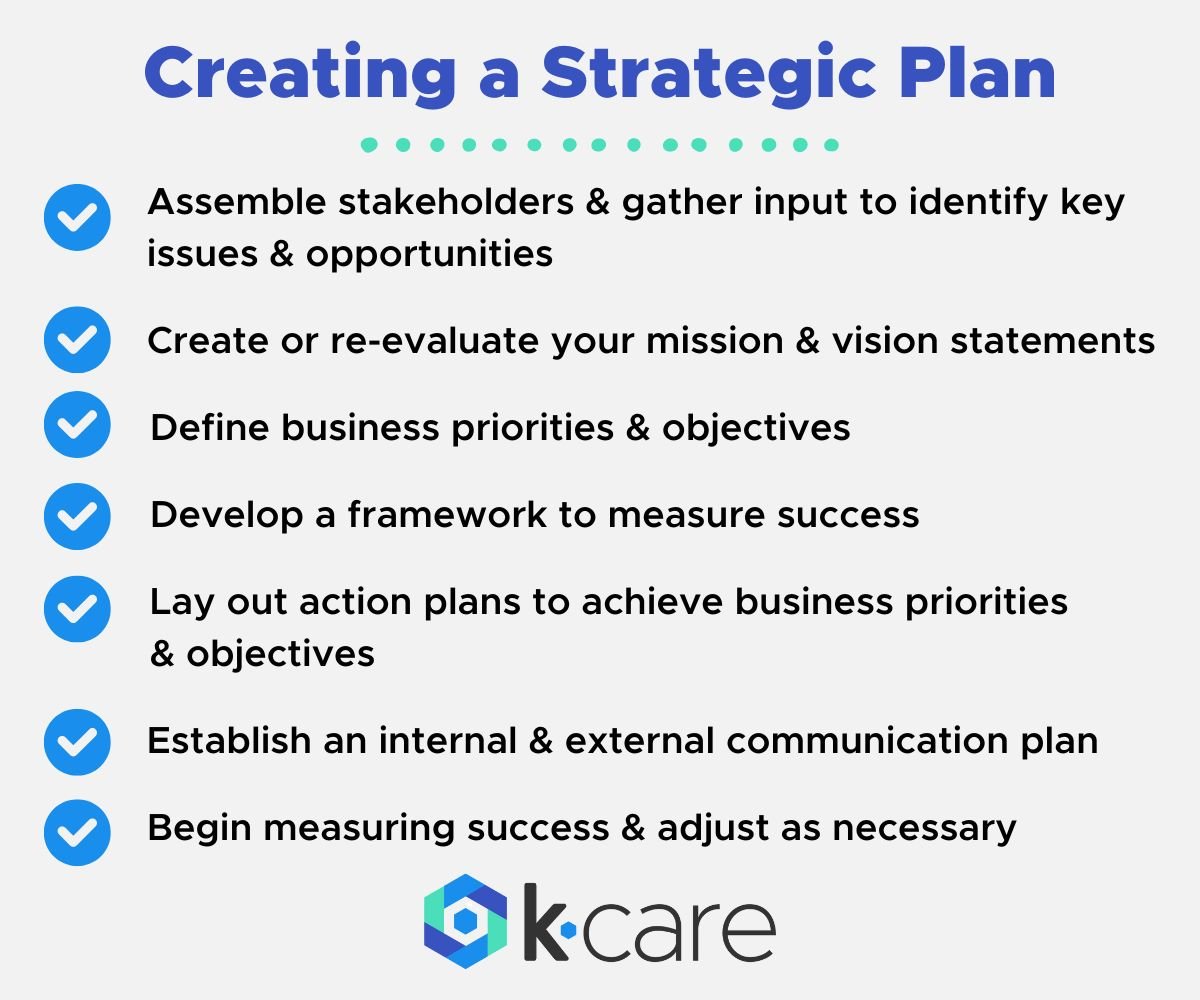Straight From the Expert: How to Achieve CARF Accreditation Success
Creating a Plan for Achieving CARF Accreditation
If you have a mental health and human services agency, then you might be interested in learning more about CARF (Commission on Accreditation of Rehabilitation Facilities) accreditation. CARF is an independent, nonprofit accreditor of health and human service organizations that ensures they meet defined standards of quality. To receive accreditation, your organization must meet rigorous CARF accreditation standards and demonstrate a commitment to continuous improvement.
Achieving accreditation is not a simple one-and-done task. It requires service providers to focus on the unique needs of the people they help, and commit to improving the overall quality of their services, while continually monitoring agency outcomes. CARF accreditation is not permanent and must be renewed periodically to ensure quality standards continue to be met.
KCare strives to help social service and behavioral health agencies succeed. In addition to our unparalleled software solutions, we offer outstanding customer support and extensive education and training resources. We are proud partners of Accreditation Guru, a national consulting firm dedicated to helping social service, behavioral health, and education organizations become successfully accredited. Jennifer Flowers, Founder & CEO of Accreditation Guru, is a wonderful source of information and advice concerning the CARF accreditation process.
Are you interested in CARF accreditation but not sure where to start? You’re in luck, because Jennifer advises organizations throughout the accreditation process, and she provides key information below.

What is the Key to CARF Accreditation Success?
Becoming accredited doesn't happen overnight. The steps to success include:
1. Conduct a gap analysis: Identify areas where the organization falls short of CARF standards. According to CARF accreditation standards, a gap analysis helps you see where your organization is, versus where it needs to be. It helps you pinpoint changes that you need to make as you work toward CARF accreditation.
2. Identify your resources: Successfully achieving CARF accreditation requires ample staff and technical resources, such as your social service software.
3. Develop an action plan: Now that you have determined what needs to happen to attain CARF accreditation, you need to create a reasonable and achievable plan to get it accomplished. According to Jennifer, “On average, it takes an organization 12 -15 months to prepare for an initial survey depending on the findings of their gap analysis."
You may want to create a tiered plan with milestones to achieve on a monthly basis. CARF accreditation is a multi-step process that requires commitment and time. Take a closer look at the steps involved, including:
• A self-evaluation
• Submitting an application
• Surveyors observing your organization's work to ensure conformity with CARF accreditation standards
• The completion of multiple written plans, including a Strategic Plan
If you need help in achieving CARF accreditation, companies like Accreditation Guru are invaluable. They have the expertise to facilitate your preparation and planning so that you can succeed, while limiting stress during the process.
What is a Strategic Plan?
Jennifer Flowers of Accreditation Guru shares this insight into what strategic planning looks like when organizations seek compliance with CARF’s strategic plan requirements:
“A strategic plan is a written document that provides a roadmap for an organization. This includes measurable, specific goals that look out to a 3-year horizon. It is a way for an organization to identify where they want to go and how to get there. This gives you an opportunity to take a look at the environment you're working in and define a service population, making sure you're still offering the types of programs they need at the right scale. A strategic plan helps asset allocation and the like.”
Does this sound like a lot to tackle? Just like accreditation, strategic planning doesn't happen overnight. Jennifer and the experts at Accreditation Guru can help organizations work through the plan step by step.
To create a strategic plan, you need to:
• Identify and assemble the right people to develop the strategic plan – the leadership team is key
• Conduct interviews to gather input from both internal and external sources to identify key issues and opportunities
• Create or re-evaluate your mission and vision statements
• Define business priorities and objectives
• Develop a framework to measure success
• Lay out action plans to achieve business priorities and objectives
• Establish an internal and external communication plan
• Begin measuring success and adjust as necessary
1. Complete a self-assessment of your organization.
Self-assessments help you understand where your organization is, where you want it to be, and how much needs to be accomplished before you reach your desired destination. Collecting data will help you evaluate whether your organization is currently meeting its target goals effectively. Find out which areas of your organization are doing well, and which areas need improvement.
If you have a mission or vision statement, your self-assessment can address whether you are in line with that statement, or if the statement needs adjustment.
Some practical ways to begin a self-assessment include getting key information from internal and external sources through interviews, surveys, or questionnaires. You might want to dive a little deeper by forming focus groups, so you can get information from different aspects of your organization, such as finance, marketing, etc. You can perform a SWOT analysis, which looks at strengths, weaknesses, opportunities, and threats related to your organization. Consider comparing your organization’s processes to those of a similar organization.
2. Meet with directors and staff to collect information on current processes.
You can't complete the strategic planning process alone. You need the other people in your organization to work with you, back you up, and help you plan. Jennifer says, "Everyone is busy, but when a team knows that this is going to have an impact on their daily work and make their jobs easier and allow them to serve their clients better, they will be interested."
Meeting with directors and staff members will also help you get a feel for who in leadership might be the best at strategic planning. Another added benefit of this step is the increased communication you initiate within your organization. The more your people communicate together, the better you can understand the various processes that occur within the organization.
3. Conduct a gap analysis to identify areas where the organization falls short of meeting your mission and vision goals.
A gap analysis helps you see where your organization is, versus where it needs to be. It helps you pinpoint changes that you need to make for the fulfillment of your mission and vision.
There are different models which you can follow when performing a gap analysis. Forbes explains a simple, four-point approach:
• Identify your current situation. Use your self-assessment to put into words where your organization is at present. This can be in terms of finances, mission, number of services provided, and so on. Be as thorough as possible in creating an accurate picture of your current organization.
• Set S.M.A.R.T. goals of where you want to be. S.M.A.R.T. stands for specific, measurable, achievable, relevant, and time sensitive. These types of goals will help you succeed. An example of an overarching goal may be to improve the quality and safety of services provided, and a specific goal may be to achieve CARF accreditation. You can set more specific objectives that happen within the 12–15-month timeline.
• Get to the root of the problem through gap analysis. Dig into your data to discover what is keeping you from your goals. Is it related to funding? Staffing? Location? Time? Lack of technological resources? Be honest with yourself during this step of the analysis.
• Make a plan to close the gaps. Determine what you need to do to reach your goals. This leads directly to the next step of strategic planning.
4. Develop an action plan.
Now that you have determined what needs to happen to attain your strategic goals, you need to create a reasonable and achievable plan to make it happen. You may want to create an ambitious plan that really goes hard for the goal, but Jennifer cautions agencies about setting goals that are not achievable in the given timeline. She says, "Keep your eye on the horizon. So many times, in planning mode, agencies look at the next 6-12 months and their plan needs to look out for three years. Once the plan is approved by directors, immediately follow up and write an annual plan."
You may want to create a tiered plan with goals to achieve within six months, 12 months, 18 months, 20 months, and up to three years. Chances are, there is more than one thing your organization needs to do to fulfill its mission and reach its vision. Don't try to fit it all into one “super plan”.
5. Evaluate technology and resources.
CARF expects agencies to understand current and future technological advances to determine how they will be supporting agency operations. You know that technology and resources evolve and improve all the time. These changes can leave some leaders feeling like they will never be able to keep up, so why try? Technology changes because our needs in society change. Five years ago, you may not have needed telehealth technology, but now it's something many organizations have learned how to implement in their daily operations. Maybe you don't understand how a cloud-based EHR (electronic health record) software works, or why it is preferable to paper filing. Part of your evaluation should include recognizing the questions you have about new technology. You can then do research or seek consultation from those who know the answers to your questions.
Jennifer understands that organizations need to have solid tech plans to move forward and ensure the continued quality of services. She recommends asking yourself the following questions:
• What technology are we using now?
• How long do we anticipate using this technology?
• What will we need in the future?
• How are our employees' technological skills?
• Does any training or retraining need to happen?
• How much time and money will this take?
• Is anything not working?
KCare’s EHR software, Exym, makes it easier for you to get on board with the latest technology geared toward behavioral health. Exym offers seamless connectivity and outstanding reliability, and is fully HIPAA-compliant. A comprehensive EHR solution will also help you achieve better consistency within your agency, streamline your tasks so you can get more done, and improve communication between your staff members and clients.
Seek Guidance Whenever Possible
You don't have to do it alone! Organizations like KCare and Accreditation Guru are here for you. Accreditation Guru will partner with your organization to prepare for accreditation, including the development of a written plan that will be conformant with CARF accreditation standards and strategic plan. This process will facilitate changes in your organization so that you can more successfully fulfill your own mission.
Would you like to know more about Accreditation Guru's approach to achieving CARF accreditation and strategic planning? Check out their website and then sign up for a free, no-obligation consultation. Once CARF accreditation is achieved, you can rely on Accreditation Guru's continued support as you face new challenges and navigate the reaccreditation process.
About KCare
KCare is a suite of innovative software solutions designed for behavioral health and human services organizations. Our industry-leading EHR, case management, and analytics products are designed to boost employee efficiency while improving client outcomes. For over 25 years, providers have trusted KCare to transform how they deliver care through our software solutions, including extendedReach, Exym, and Stabilify.
As a certified B Corporation, we operate our business in accordance with the highest standards of verified social and environmental performance, public transparency, and legal accountability. We are also part of the global Pledge 1% movement, donating 1% of our profits to the communities served by our customers.

 By
By



